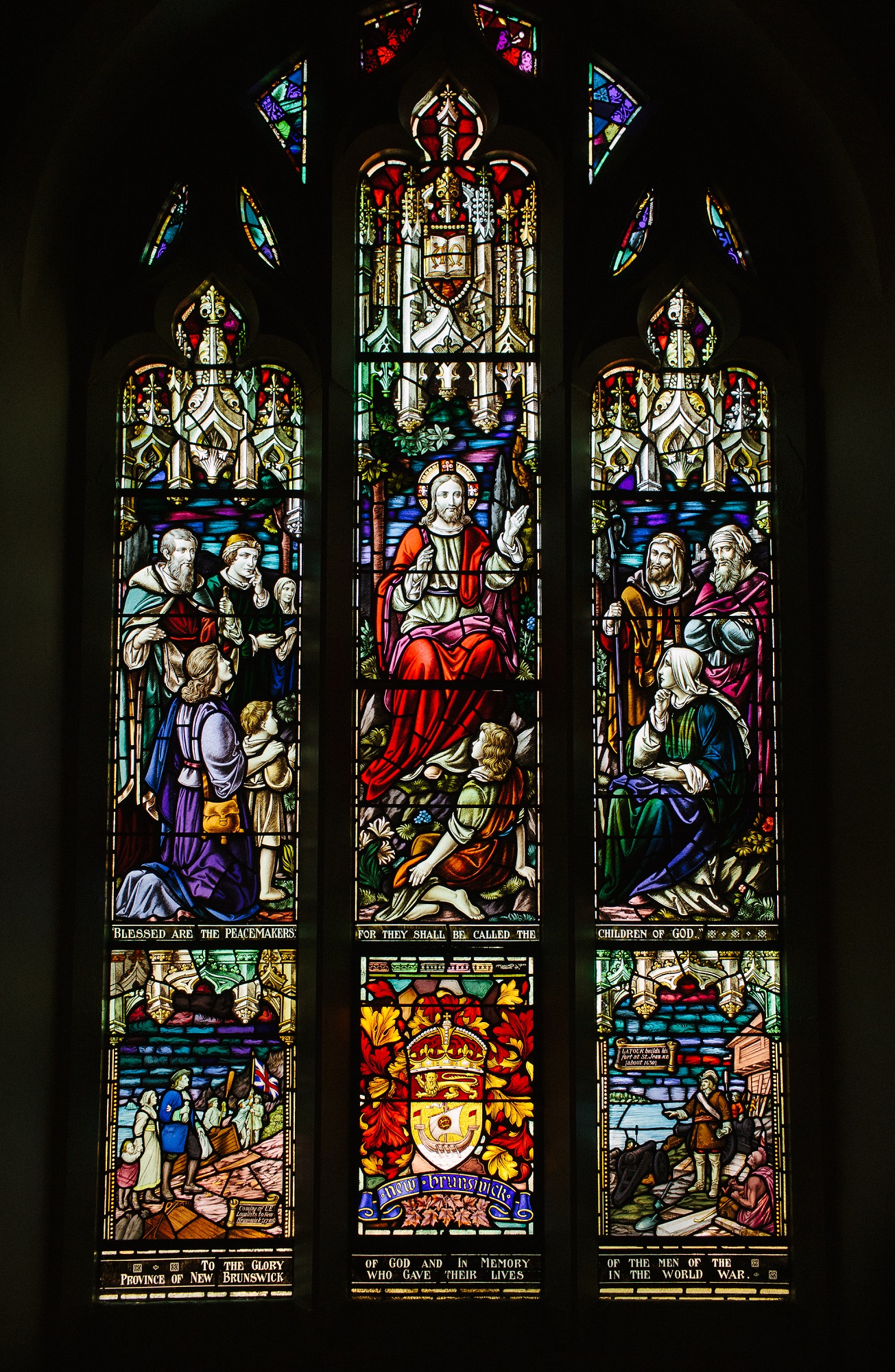New Brunswick Window
Municipality/Province: Vancouver, BC
Memorial number: 59026-042
Type: Stained glass window
Address: Burrard Street and W 15th Avenue
Location: Canadian Memorial United Church
GPS coordinates: Lat: 49.2580818 Long: -123.1459623
Submitted by: Canadian Memorial United Church. A Padre's Pilgrimage, Toronto: The Ryerson Press.
Photo credit: Canadian Memorial United Church and Centre for Peace
Canadian Memorial Chapel was born in the hearts of private soldiers in the First World War who, guided by a sergeant, formed a working party to bury six of Canada's war dead. On a November night of 1915, in the Ypres Salient, France, one of the soldiers said to Reverend Lieutenant-Colonel (Lt.-Col.) George Fallis, CBE, ED, DD: "Padre, after the war is over some chaplain should build a memorial in Canada in memory of fellows like these who have given their all." From that moment on, he would never lay away their beloved dead without the idea of a memorial chapel in his mind.
On his return to Canada he was advised by Reverend S.D. Chown, DD, General Superintendent of the Methodist Church, to go to Vancouver and choose a site in Shaughnessy Heights facing the eternal hills to erect the chapel of his dreams. He arrived in Vancouver in May 1920, to a willing congregation and plans were quickly laid.
Lt.-Col. Fallis' friend Chris Spencer, CBE, advised him that in order for there to be national significance to the chapel, he should go across Canada and interview lieutenant governors, premiers, statesmen and leaders of each province, asking them to underwrite the windows. New Brunswick was the fourth province he visited.
As Lt.-Col. Fallis was travelling by train from Saint John to Fredericton he met Mr. McLean and spoke of his mission to the Maritimes and of the success so far. Mr. McLean gave him a letter of introduction to the Lieutenant Governor and before getting off the train said he'd like to be a subscriber for the New Brunswick window and handed him a bit of blue paper. After he got off the train, Lt.-Col. Fallis unfolded the paper and it was a cheque for five hundred dollars.
When Mr. McLean left the train it dawned on him that Lt.-Col. Fallis was the chaplain who had buried the son of Mr. O'Leary of Richibucto. He called him by long distance and told him that Lt.-Col. Fallis would be speaking in Saint John at the Admiral Beattie Hotel the following Thursday. Mr. O'Leary travelled from Richibucto to Saint John with a letter Lt.-Col. Fallis had written in the fall of 1915 from Ploegstreet Wood where he had laid Mr. O’Leary’s son in Le Rossignol Cemetery. Trooper O'Leary was a Catholic and Lt.-Col. Fallis could not find a Roman Catholic priest to bury him, so tried all the harder to compose a letter of insight and comfort to a father and mother of another faith. Mr. O'Leary spoke of his two brothers in the Roman Catholic Church, one the Archbishop of Prince Edward Island, and the other the Archbishop of Edmonton. He left Lt.-Col. Fallis with a short note to say that Mr. McLean had told him about Canadian Memorial Chapel, and that he felt Lt.-Col. Fallis was building a memorial not only for the Protestants, but also for the Catholics of Canada and that he would be grateful if his attached cheque would be accepted as a subscription.
Years later, Lt.-Col. Fallis greeted two men standing before the New Brunswick window and they revealed that they were the brothers of Mr. O'Leary of Richibucto, New Brunswick, and they were viewing the window that their brother had written about and told them to see.
Fredericton, Saint John and Moncton all responded to the appeal for a Memorial Chapel. Mr. Howard P. Robinson gave great assistance.
Depicted in the New Brunswick Window - “The Sermon on the Mount.” Jesus tells his followers that those who suffer, mourn, and who are meek and righteous will be blessed by God. One historical window shows La Tour, protector of the Acadian people. Another illustrates the United Empire Loyalists coming to Canada to escape retribution by the newly formed American nation. Both represent peoples suffering under the persecution of others. The UE Loyalists claimed land that had been taken away from the Acadians a mere 20 years before. In some ways the window represents the cycle of violence in which the persecuted become the persecutor. As such, it demonstrates a need to return to the Sermon on the Mount: “Blessed are those who are persecuted for righteousness’ sake, for theirs is the Kingdom of Heaven.”
Inscription found on memorial
"BLESSED ARE THE PEACEMAKERS. FOR THEY SHALL BE CALLED THE CHILDREN OF GOD."
Coming of U.E.
Loyalists to New
Brunswick 1783
LATOUR builds his
fort at St. Jean NB
(about 1630)
new brunswick
TO THE GLORY OF GOD AND IN MEMORY OF THE MEN OF THE
PROVINCE OF NEW BRUNSWICK WHO GAVE THEIR LIVES IN THE WORLD WAR.
Street view
Note
This information is provided by contributors and Veterans Affairs Canada makes it available as a service to the public. Veterans Affairs Canada is not responsible for the accuracy, currency or reliability of the information.
- Date modified:
